Arian Hosseini
Multi-Turn Puzzles: Evaluating Interactive Reasoning and Strategic Dialogue in LLMs
Aug 13, 2025Abstract:Large language models (LLMs) excel at solving problems with clear and complete statements, but often struggle with nuanced environments or interactive tasks which are common in most real-world scenarios. This highlights the critical need for developing LLMs that can effectively engage in logically consistent multi-turn dialogue, seek information and reason with incomplete data. To this end, we introduce a novel benchmark comprising a suite of multi-turn tasks each designed to test specific reasoning, interactive dialogue, and information-seeking abilities. These tasks have deterministic scoring mechanisms, thus eliminating the need for human intervention. Evaluating frontier models on our benchmark reveals significant headroom. Our analysis shows that most errors emerge from poor instruction following, reasoning failures, and poor planning. This benchmark provides valuable insights into the strengths and weaknesses of current LLMs in handling complex, interactive scenarios and offers a robust platform for future research aimed at improving these critical capabilities.
Putting the Value Back in RL: Better Test-Time Scaling by Unifying LLM Reasoners With Verifiers
May 07, 2025Abstract:Prevalent reinforcement learning~(RL) methods for fine-tuning LLM reasoners, such as GRPO or Leave-one-out PPO, abandon the learned value function in favor of empirically estimated returns. This hinders test-time compute scaling that relies on using the value-function for verification. In this work, we propose RL$^V$ that augments any ``value-free'' RL method by jointly training the LLM as both a reasoner and a generative verifier using RL-generated data, adding verification capabilities without significant overhead. Empirically, RL$^V$ boosts MATH accuracy by over 20\% with parallel sampling and enables $8-32\times$ efficient test-time compute scaling compared to the base RL method. RL$^V$ also exhibits strong generalization capabilities for both easy-to-hard and out-of-domain tasks. Furthermore, RL$^V$ achieves $1.2-1.6\times$ higher performance when jointly scaling parallel and sequential test-time compute with a long reasoning R1 model.
When To Solve, When To Verify: Compute-Optimal Problem Solving and Generative Verification for LLM Reasoning
Apr 01, 2025Abstract:Scaling test-time compute has emerged as a key strategy for enhancing the reasoning capabilities of large language models (LLMs), particularly in tasks like mathematical problem-solving. A traditional approach, Self-Consistency (SC), generates multiple solutions to a problem and selects the most common answer via majority voting. Another common method involves scoring each solution with a reward model (verifier) and choosing the best one. Recent advancements in Generative Reward Models (GenRM) reframe verification as a next-token prediction task, enabling inference-time scaling along a new axis. Specifically, GenRM generates multiple verification chains-of-thought to score each solution. Under a limited inference budget, this introduces a fundamental trade-off: should you spend the budget on scaling solutions via SC or generate fewer solutions and allocate compute to verification via GenRM? To address this, we evaluate GenRM against SC under a fixed inference budget. Interestingly, we find that SC is more compute-efficient than GenRM for most practical inference budgets across diverse models and datasets. For instance, GenRM first matches SC after consuming up to 8x the inference compute and requires significantly more compute to outperform it. Furthermore, we derive inference scaling laws for the GenRM paradigm, revealing that compute-optimal inference favors scaling solution generation more aggressively than scaling the number of verifications. Our work provides practical guidance on optimizing test-time scaling by balancing solution generation and verification. The code is available at https://github.com/nishadsinghi/sc-genrm-scaling.
Asynchronous RLHF: Faster and More Efficient Off-Policy RL for Language Models
Oct 23, 2024



Abstract:The dominant paradigm for RLHF is online and on-policy RL: synchronously generating from the large language model (LLM) policy, labelling with a reward model, and learning using feedback on the LLM's own outputs. While performant, this paradigm is computationally inefficient. Inspired by classical deep RL literature, we propose separating generation and learning in RLHF. This enables asynchronous generation of new samples while simultaneously training on old samples, leading to faster training and more compute-optimal scaling. However, asynchronous training relies on an underexplored regime, online but off-policy RLHF: learning on samples from previous iterations of our model. To understand the challenges in this regime, we investigate a fundamental question: how much off-policyness can we tolerate for asynchronous training to speed up learning but maintain performance? Among several RLHF algorithms we tested, we find that online DPO is most robust to off-policy data, and robustness increases with the scale of the policy model. We study further compute optimizations for asynchronous RLHF but find that they come at a performance cost, giving rise to a trade-off. Finally, we verify the scalability of asynchronous RLHF by training LLaMA 3.1 8B on an instruction-following task 40% faster than a synchronous run while matching final performance.
Not All LLM Reasoners Are Created Equal
Oct 02, 2024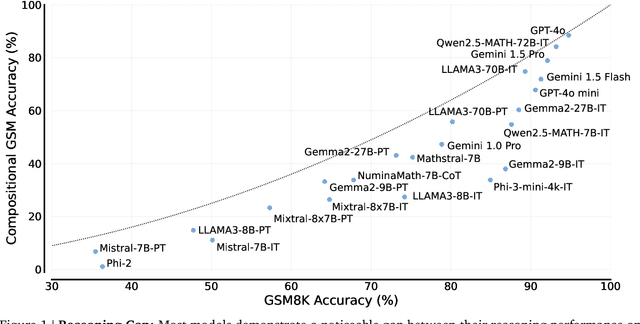
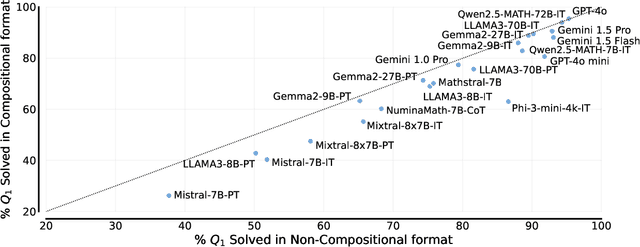
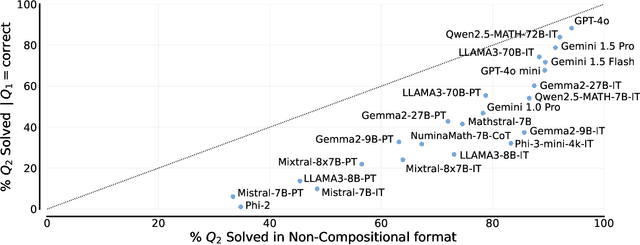
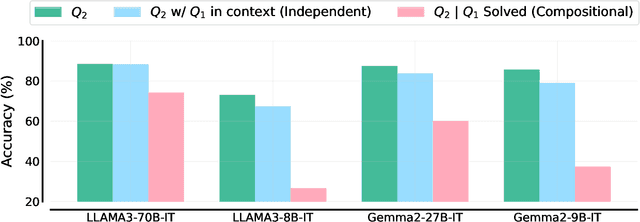
Abstract:We study the depth of grade-school math (GSM) problem-solving capabilities of LLMs. To this end, we evaluate their performance on pairs of existing math word problems together so that the answer to the second problem depends on correctly answering the first problem. Our findings reveal a significant reasoning gap in most LLMs, that is performance difference between solving the compositional pairs and solving each question independently. This gap is more pronounced in smaller, more cost-efficient, and math-specialized models. Moreover, instruction-tuning recipes and code generation have varying effects across LLM sizes, while finetuning on GSM can lead to task overfitting. Our analysis indicates that large reasoning gaps are not because of test-set leakage, but due to distraction from additional context and poor second-hop reasoning. Overall, LLMs exhibit systematic differences in their reasoning abilities, despite what their performance on standard benchmarks indicates.
Smaller, Weaker, Yet Better: Training LLM Reasoners via Compute-Optimal Sampling
Aug 29, 2024



Abstract:Training on high-quality synthetic data from strong language models (LMs) is a common strategy to improve the reasoning performance of LMs. In this work, we revisit whether this strategy is compute-optimal under a fixed inference budget (e.g., FLOPs). To do so, we investigate the trade-offs between generating synthetic data using a stronger but more expensive (SE) model versus a weaker but cheaper (WC) model. We evaluate the generated data across three key metrics: coverage, diversity, and false positive rate, and show that the data from WC models may have higher coverage and diversity, but also exhibit higher false positive rates. We then finetune LMs on data from SE and WC models in different settings: knowledge distillation, self-improvement, and a novel weak-to-strong improvement setup where a weaker LM teaches reasoning to a stronger LM. Our findings reveal that models finetuned on WC-generated data consistently outperform those trained on SE-generated data across multiple benchmarks and multiple choices of WC and SE models. These results challenge the prevailing practice of relying on SE models for synthetic data generation, suggesting that WC may be the compute-optimal approach for training advanced LM reasoners.
Generative Verifiers: Reward Modeling as Next-Token Prediction
Aug 27, 2024



Abstract:Verifiers or reward models are often used to enhance the reasoning performance of large language models (LLMs). A common approach is the Best-of-N method, where N candidate solutions generated by the LLM are ranked by a verifier, and the best one is selected. While LLM-based verifiers are typically trained as discriminative classifiers to score solutions, they do not utilize the text generation capabilities of pretrained LLMs. To overcome this limitation, we instead propose training verifiers using the ubiquitous next-token prediction objective, jointly on verification and solution generation. Compared to standard verifiers, such generative verifiers (GenRM) can benefit from several advantages of LLMs: they integrate seamlessly with instruction tuning, enable chain-of-thought reasoning, and can utilize additional inference-time compute via majority voting for better verification. We demonstrate that when using Gemma-based verifiers on algorithmic and grade-school math reasoning tasks, GenRM outperforms discriminative verifiers and LLM-as-a-Judge, showing a 16-64% improvement in the percentage of problems solved with Best-of-N. Furthermore, we show that GenRM scales favorably across dataset size, model capacity, and inference-time compute.
The N+ Implementation Details of RLHF with PPO: A Case Study on TL;DR Summarization
Mar 24, 2024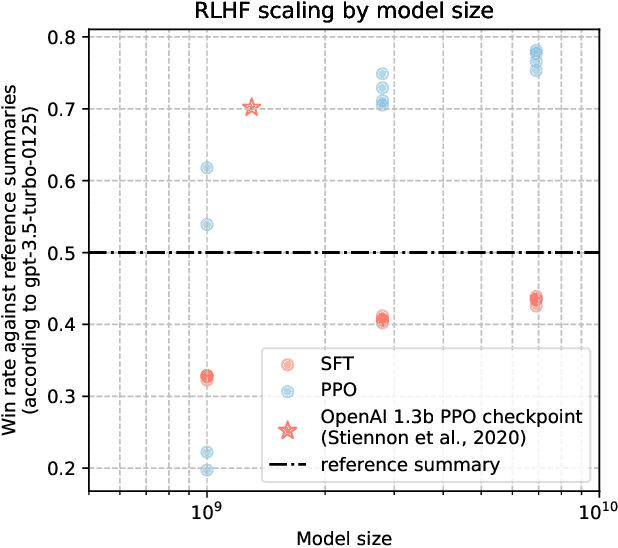
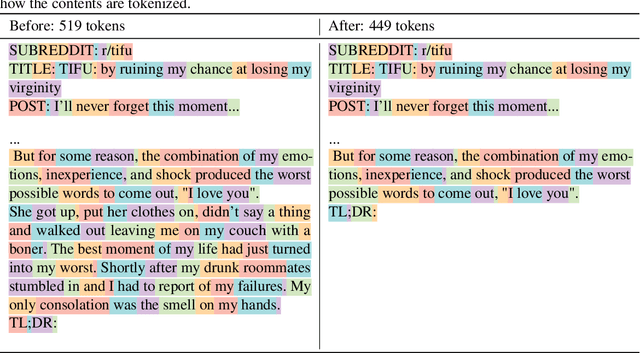
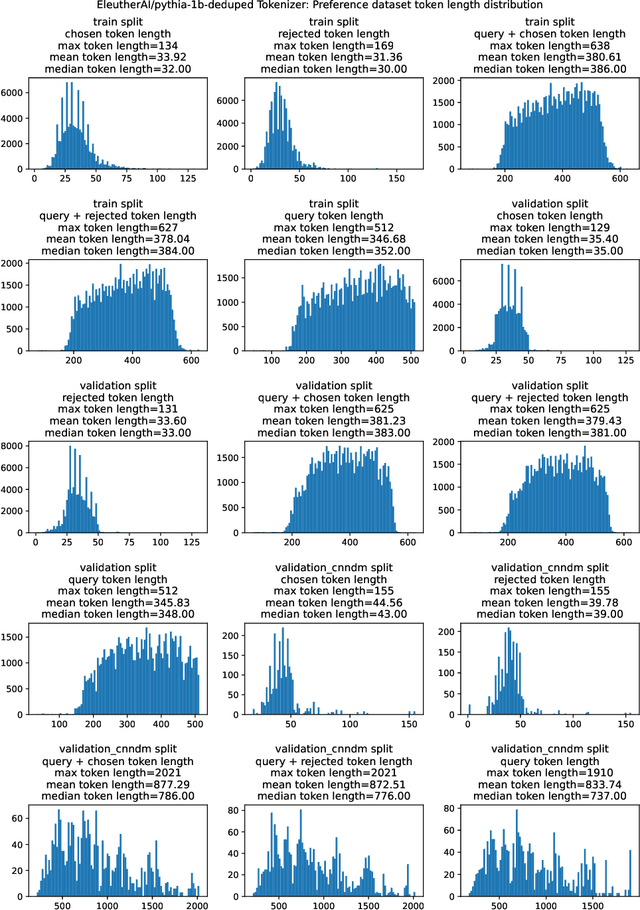

Abstract:This work is the first to openly reproduce the Reinforcement Learning from Human Feedback (RLHF) scaling behaviors reported in OpenAI's seminal TL;DR summarization work. We create an RLHF pipeline from scratch, enumerate over 20 key implementation details, and share key insights during the reproduction. Our RLHF-trained Pythia models demonstrate significant gains in response quality that scale with model size, with our 2.8B, 6.9B models outperforming OpenAI's released 1.3B checkpoint. We publicly release the trained model checkpoints and code to facilitate further research and accelerate progress in the field (\url{https://github.com/vwxyzjn/summarize_from_feedback_details}).
V-STaR: Training Verifiers for Self-Taught Reasoners
Feb 09, 2024


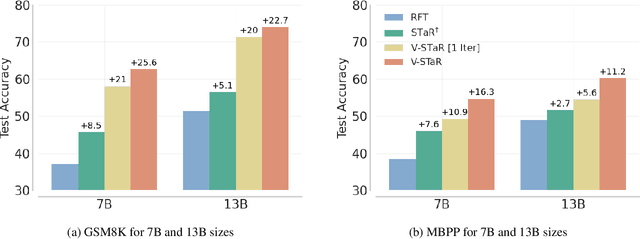
Abstract:Common self-improvement approaches for large language models (LLMs), such as STaR (Zelikman et al., 2022), iteratively fine-tune LLMs on self-generated solutions to improve their problem-solving ability. However, these approaches discard the large amounts of incorrect solutions generated during this process, potentially neglecting valuable information in such solutions. To address this shortcoming, we propose V-STaR that utilizes both the correct and incorrect solutions generated during the self-improvement process to train a verifier using DPO that judges correctness of model-generated solutions. This verifier is used at inference time to select one solution among many candidate solutions. Running V-STaR for multiple iterations results in progressively better reasoners and verifiers, delivering a 4% to 17% test accuracy improvement over existing self-improvement and verification approaches on common code generation and math reasoning benchmarks with LLaMA2 models.
Deep Language Networks: Joint Prompt Training of Stacked LLMs using Variational Inference
Jun 21, 2023



Abstract:We view large language models (LLMs) as stochastic \emph{language layers} in a network, where the learnable parameters are the natural language \emph{prompts} at each layer. We stack two such layers, feeding the output of one layer to the next. We call the stacked architecture a \emph{Deep Language Network} (DLN). We first show how to effectively perform prompt optimization for a 1-Layer language network (DLN-1). We then show how to train 2-layer DLNs (DLN-2), where two prompts must be learnt. We consider the output of the first layer as a latent variable to marginalize, and devise a variational inference algorithm for joint prompt training. A DLN-2 reaches higher performance than a single layer, sometimes comparable to few-shot GPT-4 even when each LLM in the network is smaller and less powerful. The DLN code is open source: https://github.com/microsoft/deep-language-networks .
 Add to Chrome
Add to Chrome Add to Firefox
Add to Firefox Add to Edge
Add to Edge